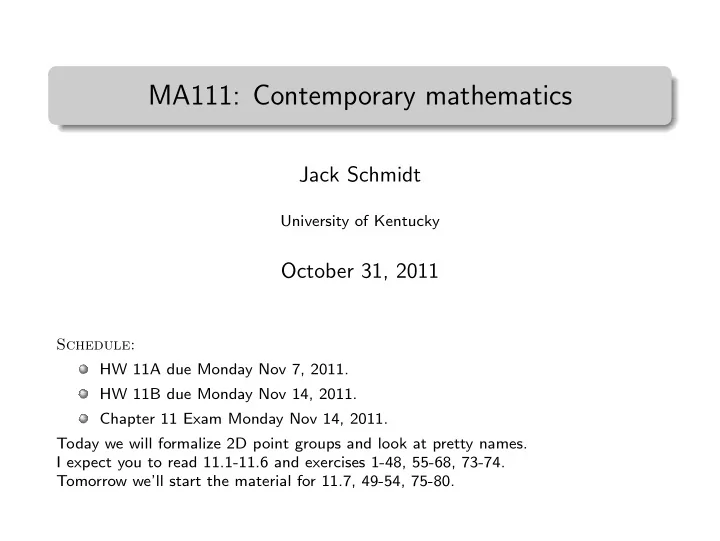

. MA111: Contemporary mathematics . Jack Schmidt University of Kentucky October 31, 2011 Schedule: HW 11A due Monday Nov 7, 2011. HW 11B due Monday Nov 14, 2011. Chapter 11 Exam Monday Nov 14, 2011. Today we will formalize 2D point groups and look at pretty names. I expect you to read 11.1-11.6 and exercises 1-48, 55-68, 73-74. Tomorrow we’ll start the material for 11.7, 49-54, 75-80.
11.2 - 11.5: rigid motions Chapter 11 studies symmetries of flat things An infinite blank sheet of (flat) paper has four kinds of symmetries: Rotations These leave one point alone, and swirl the rest around Specified by the center and angle “rotocenter” and “order” Reflections These leave one line alone, and flip the rest over it Specified by the line of reflection These switch left with right (or top and bottom) Translations These move all points, but preserve left-right Specified by a direction and distance “vector” Glide reflections These move all points, and switch left-right Specified by a direction and distance “vector”
11.1 and 11.6: 2D Point Groups If our object is “bounded” then we cannot use translations or glide reflections (it would “float away”) The symmetries of such an object are only rotations and reflections The complete classification: Find the rotation of the largest order, n Does it have reflections? Yes: D n No: Z n D n has n rotations (including the all-the-way-around 360 o does-not-change-anything rotation) and n reflections (all of them really-real actually-flips-some-stuff reflections) Z n has n rotations and 0 reflections
Exercises 57-62: Multiplying symmetries “A” and “B” are some symmetries of the flat world If “A” leaves a shape alone, and “B” leaves a shape alone, then actually we know some other things that leave the shape alone: “A ∗ B” meaning “A, then B” leaves the shape alone A rectangle stays the same after a vertical flip, “A” and after a horizontal flip, “B” It must stay the same after “A ∗ B” too: but what is a simplified name for “A ∗ B”?
73-74 and 11.7: Groups A symmetry group is a list of symmetries so that if “A” and “B” are in the list, so is “A ∗ B” (and so that if “A” is in the list, so is “1/A” the opposite of “A”) A symmetry group defines what it means for two points to be the same: if you can get from one to the other using a symmetry in the list Symmetry lets us simplify problems (graph theory example) A discrete symmetry group is one in which there is some distance D such that two points closer than D cannot be the same Classification: A discrete symmetry group of the flat world is: Z n or D n (the Rosette Groups), or One of 7 Frieze Groups, or One of 17 Wallpaper Groups
Project B: More useful symmetry In three dimensions there are 6 basic rigid motions Rotary reflections and screws are new Instead of Z n and D n we get 7 letters (and also 7 freakazoids) Most of the time these are used for crystal lattices Only 32 possible letter/number combinations for crystals 230 “full” crystal groups (like Wallpapers) There are 80 “almost full” (Layer) crystal groups, and 75 “barely full” (Rod) crystal groups
Recommend
More recommend